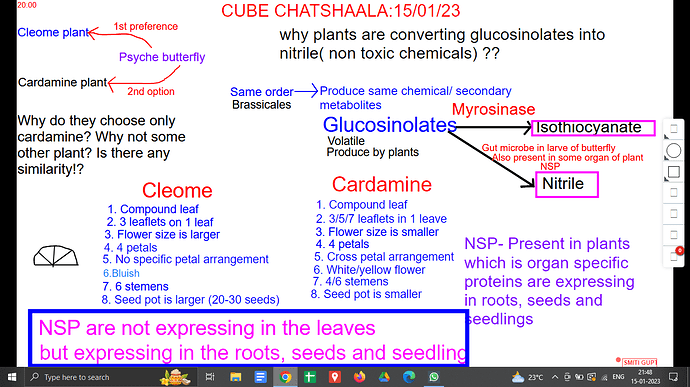![]() Today we started discussion with @Theertha and @Shraddha276 observation on Cleome plant and interaction of psyche butterfly with Cardamine and Cleome plant
Today we started discussion with @Theertha and @Shraddha276 observation on Cleome plant and interaction of psyche butterfly with Cardamine and Cleome plant
![]() Where @Shraddha276 told that their 1st preference is Cleome plant but if the quantity of Cleome plant decrease by any chance, then it can also use Cardamine as host plant
Where @Shraddha276 told that their 1st preference is Cleome plant but if the quantity of Cleome plant decrease by any chance, then it can also use Cardamine as host plant
![]() @bhagwati ma’am had a question that why do psyche butterfly only choose cardamine as their 2nd option and not any other plant?
@bhagwati ma’am had a question that why do psyche butterfly only choose cardamine as their 2nd option and not any other plant?
![]() Although Cleome and cardamine don’t look similar (morphologically), they belong to same order that is Brassicales cause they produce same chemical
Although Cleome and cardamine don’t look similar (morphologically), they belong to same order that is Brassicales cause they produce same chemical
![]() Then we discussed about those chemicals, secondary metabolites and how they are been converted?
Then we discussed about those chemicals, secondary metabolites and how they are been converted?
• Why do plants have these nontoxic chemicals instead of toxic chemicals?
• And what happens when larve of butterfly feeds on this plants?
Then we had a brief discussion on the this paper.
Chemical behaviour of Leptosia nina in host plant
selection and the GCMS analysis of Cardamine hirsuta
By Dhrishya. V. S, @binumoll2 ma’am
In Journal of Emerging Technologies and Innovative Research
Reference shared during chatshaala discussion ![]()
https://indiabiodiversity.org/species/show/229206
Cleome is a genus of flowering plants in the family Cleomaceae, commonly known as spider flowers, spider plants, spider weeds, or bee plants.[2][3] Previously, it had been placed in the family Capparaceae, until DNA studies found the Cleomaceae genera to be more closely related to the Brassicaceae than the Capparaceae. Cleome and clammyweed, (Polanisia dodecandra) can sometimes be confused. The simplest way to differentiate the two is to compare the seedpods which project out or down on cleome and up on clammyweed.
My comments on the paper - Chemical behaviour of Leptosia nina in host plant selection and the GCMS analysis of Cardamine hirsuta
-
“COLLECTION OF MATERIAL” “Ripe yellow pods of C. hirsuta were collect from Homi Bhabha Centre for Science Education, Mumbai. The pods burst open and sawn in the home garden for germination. After a few weeks, the plants were grown up to maturity and started to flowering and seed setting…”
What were the growth conditions of the plant? -
“INCIDENCE OF PSYCHE” “…life cycle of the caterpillar was observed. From the observation, it was found that the butterfly emerging from the caterpillar’s pupa was Psyche”
Does observing the life cycle of the caterpillar is enough to prove that the butterfly emerging from the caterpillar is Leptosia nina? Bioinformatics techniques (such as DNA barcoding) might prove beneficial for confirming the specie of the butterfly, scientifically. NOTE: DNA Barcoding-DNA barcoding is a method used to identify species. It works by analysing a specific region of DNA. This region is called the DNA barcode. The sequence of this DNA barcode is then compared to a reference library which contains information of many species linked to their barcodes (for our reference) -
GC analysis of the leaf should’ve been performed before the caterpillar fed on it too, to show the difference in the chemical compounds detected before and after the analyses. Benzyl Nitrile was detected in the leaf extract after the caterpillar fed on it- there was no evidence that benzyl nitrile was not present in the leaf before the caterpillar fed on it.
-
“The result revealed the presence of Benzyl Nitriles in the leaf extract. When the larvae of psyche eat the leaves of C. hirsuta plant, the benzyl glucosinolates present in the leaves was hydrolyzed into benzyl nitrile due to the combined action of plant myrosinase and larval gut NSP protein.”
The benzyl glucosinolates present in the leaves get hydrolyzed into benzyl nitrile due to the combined action of plant “myrosinase” and “larval gut NSP protein”. As per the information, it is assumed that benzyl glucosinates are converted into benzyl nitriles in the “gut of the larva” since NSP- the key protein that facilitates the conversion is present in the larva’s gut. What could be the possible reason behind the presence of benzyl nitrile in the leaf extract instead of the larva’s gut. -
It’s hard to understand the results of GC analysis by looking at the graph. There’s a scope of improvement for GC graph and picture representation as well.
https://www.jetir.org/papers/JETIR2204384.pdf
link of paper by Drishya and Dr.Binumol maam
